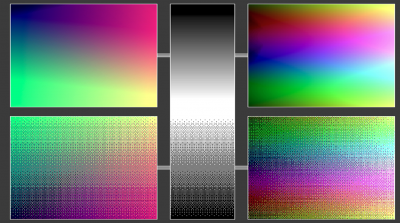Troubleshooting
From Medusa
Info on OLED
Lines:
- - used A/D chip (RGB or SDTV) and input (SCART/VGA for RGB and S-VIDEO/CVBS for SDTV) or firmware version when there is no input signal
- - detected mode, for RGB name of the system ("Atari ST PAL", "Amiga PAL" itp.), for SDTV detected signal standard (PAL, NTSC, SECAM with type) or "NO INPUT SIGNAL"
- - Horizontal frequency of input signal
- - Vertival frequency of input (and output) signal
- - Flags (such as LINEDBL - line doubling)
- - Current DVI window (you may think of it as a "resolution")
- - Screen shift horizontal:vertical
- - Working Pixel Frequency
Front LED color
- Red - RGB signal detected
- Green - SDTV signal detected
- Yellow - both signals detected (RGB on VGA and SDTV on SCART) - in this mode you may switch input using "middle" button
- Blue - firmware flash / clearing settings
- Nothing - no input signal detected
Troubleshooting
- No Picture
When you connect Medusa to your displaying device even without any signal on input you should see control picture (on the left)
- Check if your DVI window is set to default (DVI: 720x576) - if not then reset current settings (reset -> rst curr prof) or manually change window to 720x576 (shift/size -> dvi presets -> 720x576). You may also experiment with 720x480 and 640x480, but 720x576 is most compatible window size for 50Hz.
- Check if Medusa is switched to "pure DVI" mode (global options -> DVI mode -> pure DVI). Some (especially DVI) devices do not accept audio packets and do not display anything when audio packets are present in DVI stream. Especially good old 17" and 19" VGA monitors are not compatible with audio.
- If after that your device still do not display anything it of course may mean cable problems but it also may mean that your device is not compatible with signal produced by Medusa. Control screen is generated with vertical frequency of 50Hz. Since almost all old computers also generates picture with refresh rate of 50Hz then it means that your device has to be capable of displaying 50Hz. If it is not, then you may need to find another device.
- Check input cables or try different input signal
- SDTV picture is ugly
- Try to avoid connecting signal using composite video - always use s-video cables if possible
- To reduce stripes/noise you may consider using smoothing (filter -> smoothing -> 5-10)
- If you only want monochromatic picture and you have s-video cable you may consider "hacking" Medusa and force to process luminance. Enter this commands in USB/serial console:
cmd :>scartmode rgb cmd :>setyasg 1 cmd :>rgbcurve mfg 1 cmd :>rgbcomponent 1
- RGB picture is ugly
- If your device hasn't been detected (you see "unrecognised lo" or "unrecognised hi" on second line on OLED/OSD - also you see name that do not match your device) then you should adjust manually pixels per line parameter (rgb only -> pixels/line). In such case consider contacting us. Likely we will be able to add your device to list of recognised devices in future firmwares.
- If your device has beed properly detected but picture is not crystal clear - first try to adjust sample phase (rgb only -> sample phase).
- If you see a lot of noise you may try to increase smoothing (filter -> smoothing -> 5-10), but also check power cables (yes power cables). Source of picture noise is usually on the ground signal. To reduce ground noise you may consider connecting ground of Medusa with ground of your device using separate cable. Although it is counterintuitive, change modern filtered multi-outlets into simple one (without filters, switches etc). Very often such noise is generated by power supply - try different power supply unit.
- Displaying device lost sync whenever input resolution changes
- It is normal. Medusa processes picture line by line. In such case whenever input line is missing (i.e. during input mode switch) also lines are missing on the output. Practically all displaying devices lost sync (even multisync CRT displays). Usually it means that display becomes blank for half a second or so. See the Description chapter.
